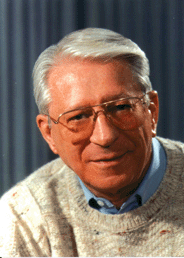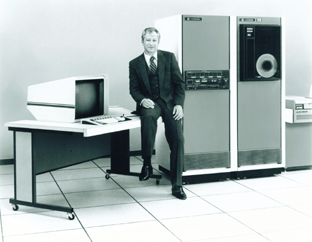Latest News
November 1, 2004
By Rachael Dalton-Taggart
This is the second in a series of profiles taking a look at the people who madethe CAD industry what it is today.
Dr. Patrick Hanratty is concerned about the CAD industry. As a developer of CADsoftware for almost 50 years, when he speaks on the subject his words carry somegravity.
Hanratty has always been a pioneer in the field, so naturally he’s currentlyworking on software to jump start what he sees as the languishing universe ofCAD. In fact, he might be the only CAD pioneer who is still actively developingsoftware.
“My wife says I have only two passions in life,” Hanratty joked this past July,“and they are software development. More seriously, though, I remain inspiredby the thought of what we should be able to do with computers in design; whatwe should be able to do next.… In the last 10 years the CAD industry has not moveda single step forward and that concerns me.”
A trailblazer in the field of developing code for Numerical Control (NC) andCAD, Hanratty was working on 3D design and engineering programming as early as1956. That’s when he was hired by the Convair Division of General Dynamics. Hemoved to General Electric in 1957 where he developed software for PRONTO—regardedas the first NC programming language.

Since then, Hanratty has lead the way in the development of numerous well-knownCAD/CAM systems. And he is credited with having driven the industry to levelsof excellence once considered impossible.
On His Own (with a very good team)
He has described himself to many people as ‘always restless’ and this dispositiontook him to General Motors Research Laboratory in 1961. As corporate coordinatorfor NC research, he developed graphics for NC portions of the company’s DAC project(design augmented by computers). In 1967, he moved on to Astronautics Corporation,which was then acquired by McDonnell Douglas. Because the new company alreadyhad its own CAD system under development, Hanratty’s project wound down and onJanuary 2, 1970—with seven people from McDonnell Douglas and $100,000—he startedIntegrated Computer Systems (ICS). The team set out to develop a complete CAD/CAMsolution on a REDCOR minicomputer using TPL (the programming language).
The new startup demonstrated ICS’s new INTERAPT software at the 1970 InternationalMachine Tool Show in Chicago. ICS demonstrated the entire cycle from design throughdrafting and NC tape preparation—a true first for the industry. The software waswell received but potential customers objected to the use of TPL. As good a programminglanguage as it might have been, it had virtually no following and sales were poor.But many features of INTERAPT were destined to show up in subsequent versionsof Hanratty’s design and NC software products. While the original product mostlyfailed, its ground-breaking genius lived on throughout the years.
“The INTERAPT technology was ahead of its time,” says Dr. David Albert, principalin the Albert-Battaglin Consulting Group. “The limitations of the hardware wasone factor, but at the same time, the manufacturers looking at INTERAPT were doubtfulthe technology could replace their very entrenched manual processes. Early adoptionhas never been a risk that manufacturers embrace.”
Abundance of Development
By early 1971, ICS was running out of money. Systems Science and Software, commonlyknown as S3, came to the rescue by acquiring ICS in mid-1971, but Hanratty resignedas soon as the acquisition was complete.
Three months later Hanratty founded a new company, Manufacturing and ConsultingServices (MCS) and set out to develop a new machine-independent version of thesoftware that had been started at ICS. This product was called ADAM (AutomatedDrafting And Machining) and on its launch was the only commercially availablemechanical drafting package. By 1972, more than a dozen software vendors had licensedADAM as the core software for their own turnkey solutions.
Simultaneously S3 filed a lawsuit against MCS because the company felt that MCSwas using the same code recently acquired in the purchase of ICS. The lawsuitwas settled after Computervision acquired S3 and the CAD products developed byComputervision started using Hanratty’s software as a development basis. During1973, Hanratty began his Ph.D. studies in information and computer science atthe University of California in Irvine.
In 1976, MCS released AD-2000, an advanced mechanical design and manufacturingproduct. This release had substantially more commands than ADAM and was writtenfor the new generation of 32-bit minicomputers that were starting to show up.These events helped AD-2000 establish Hanratty’s reputation in the CAD industry.The licensing of the technologies grew and manufacturers like Tektronix, ControlData Corporation, and Auto-Trol took product sales to new heights with AD-2000code.
“They were exciting times for the industry, but it was sometimes frustratingto work with Dr. Hanratty if you were a licensee,” says David Weisberg, an industrystrategist for Cyon Research who managed products at Tektronix and Auto-Trol duringthe seventies. “While Hanratty was busy ‘chopping down trees’ with his incredibledevelopment work, he would then move immediately on to chop down more. Meanwhilehis licensees were simply trying to make furniture out of the wood he had alreadycut and yet his supply of material never ceased.”
 ANVIL Takes Off
ANVIL Takes Off
In 1980, MCS started changing its business structure to a direct sales model,and introduced ANVIL-4000 in 1981 and also tried selling proprietary hardwareand bundled systems. The Anderson Report estimated that in 1982 MCS was doingabout $5 million in annual revenue with all sales being handled out of its Irvineheadquarters.
By 1984, MCS released its first-ever PC-based product, ANVIL-1000MD, a 2D subsetof the ANVIL-4000, available for the IBM PC/AT. (The system configuration wasa PC/AT with 640KB of memory, a 20MB hard disk, floppy, and an 80287 math coprocessor.)
“I probably met Pat Hanratty in 1984 or 1985 as I became a reseller for his Anvil-1000PC-based CAD program,” says Evan Yares, chairman of Open Design Alliance. “ANVIL-1000was an incredibly exciting product at the time, because it actually worked well,and broke through the limitations typical of PC-based products of the day. Bythen Hanratty was already a legend. He was a brilliant and opinionated genius,who was in a position where he could do just about whatever he wanted.”
In 1986, ANVIL-5000, which supported Unix workstations, was released. Again apioneering technology that was way ahead of the rest of the market, ANVIL-5000implemented a consistent user interface across applications as well as a commondouble-precision database for wireframe, surface, and solid models, and all theapplications that used this data. One of the more significant additions was anew optional solids modeling module called OMNISOLIDS, resulting in one of thefirst CAD/CAM packages to tightly integrate wireframe, surfaces, and solids.
According to The Anderson Report, at the beginning of 1987 MCS had about 100employees and was doing about $10 million in annual revenue. MCS was at a highpoint in the business cycle and loving it.
“Everyone was talking about MCS during the 1980s,” says John Krouse, editor ofEngineering Process Journal. “There was a mystique about Dr. Hanratty that servedto build his legend, and his technologies were truly so advanced that all thecomputer world was watching for what he did next as an indication of where theentire world of computers could and should go.”
The following 10 years saw a healthy number of new product releases and upgradesby MCS and Hanratty. Hanratty confirmed that revenues peaked in 1989 at just under$20 million. But the ensuing decade saw a gradually declining revenue stream inthe face of heightened competition from companies like Autodesk, SolidWorks, andParametric Technology. Currently, MCS continues to support its existing user basewith several developers and a small office staff, but it is a shadow of its former,glorious self.
Why the Decline?
This is a question in which most have an opinion, although the real reasons areknown to only one person. During our interview, Hanratty voiced his deep concernabout the industry as a whole.
“In my view there has been no technological change in the CAD industry for tenyears,” he says. “CAD systems are still hard to use. This is of huge concern.If there’s no change, there’s no growth.”
But it might be Hanratty’s genius which is responsible because it can be arguedthat the vendors have spent the last ten years making furniture out of the woodthat Hanratty cut. Promises made by software developers some 20 years ago startedbearing tangible fruit in the 1990s as they caught up with Hanratty’s groundwork.Then competing vendors built business environments so their products would keeppace and gain wide market acceptance. Many of the CAD vendors pushed ahead into3D solid modeling, an area that MCS and Hanratty had not fully exploited. It seemsthat a lot of the innovation in CAD and NC programming had been done by Hanratty,his team, and his competitors, and then it was time for the technologies to befine-tuned.
New Code for CAD
“Patrick Hanratty does not care about money, or being an Autodesk in this world,“says John Krouse. “He simply wants to create the best technology, successfullytackle the development problems, and keep the industry moving forward. That ishis mission in life.”
Everyone we asked about Dr. Hanratty had various ways of describing him, butall seemed to agree on one point: He is both brilliant and opinionated. His straightforwardmanner and honest approach has brought much praise and sometimes reproach. Butdespite the criticisms, Krouse probably got it right when he described Hanrattyas “a gentleman genius.”
This genius is currently working on technology that he feels will again changethe industry-making design systems easy to use and altering the industry’s wayof designing. We may yet see interesting developments from MCS that will bringthe entire subject of engineering software to the forefront once again. Even now,still writing code and developing software for the CAD and manufacturing industries,Hanratty lives for changing the world of CAD one algorithm at a time.
Rachael Dalton-Taggart is the founder of Strategic Reach PR. Much of the history for this article wasprovided by David Weisberg, chief industry strategist and CAD historian for CyonResearch. You can send comments about this article via e-mail to [email protected].
Product Information
MCS
Scottsdale, AZ
mcsaz.com
Subscribe to our FREE magazine, FREE email newsletters or both!
Latest News
About the Author
DE’s editors contribute news and new product announcements to Digital Engineering.
Press releases may be sent to them via [email protected].






